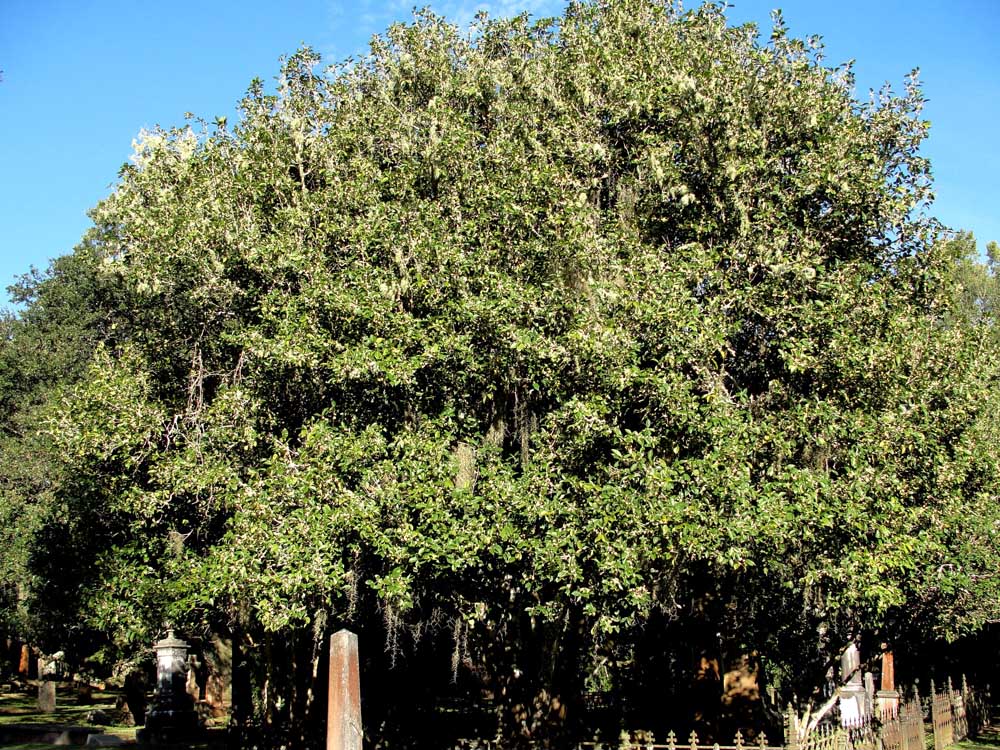Sweet olives produce one of the most distinctive garden fragrances
Published 6:45 am Thursday, October 25, 2018

- Two huge sweet olives mark a gravesite in St. Francisville, Louisiana. (Courtesy)
I recently lectured at the Southern Garden Symposium at the Grace Episcopal Church in bucolic St. Francisville, Louisiana. If you’ve never been, the stately and historic brick church is surrounded by one of the most beautiful cemeteries in the country. Thankfully, my visit back to one of my favorite places coincided with the sweet olives (Osmanthus fragrans) being in full bloom. In addition to moss-draped live oaks and a plethora of other classic Southern garden plants, the cemetery is dotted with sweet olives, including two massive ones marking a plot in the back.
The flowers of the sweet olive, which are borne in fall, early spring and sometimes mild winters, are small and a creamy white, but their perfume is powerful, one of the most distinctive of garden fragrances (and one of my all-time favorites). Originally from China, the sweet olive has been cultivated in temple and home gardens there for so long that its origins are uncertain. Following the usual route west, sweet olives were brought to England in 1771, and from there to America. This plant forms a shrub or small tree, and can reach a height of 15 feet (or obviously more in South Louisiana). Its evergreen foliage and dense form make this plant valuable as a specimen, hedge or mass.
Trending
Propagation is by cuttings and thankfully these popular plants are available in the nursery trade. Sweet olives prefer moist, deep, acidic soils but they adapt fairly well to less favorable growing conditions. An orange flowering form, known as the variety aurantiacus, is sometimes found in Southern gardens, but only blooms once per year.
Records from Rosedown Plantation in St. Francisville, Louisiana, show that its owner, Martha Turnbull, purchased three “Chinese fragrant olives (used to scent their tea)” from the New York nursery William Prince and Son in 1836. Today the scent of huge descendants from those plants permeates the entire garden during the fall and early spring.
Most of the older catalogues list sweet olive as Olea fragrans. Affleck’s Central Nurseries, near Brenham, offered it in the 1860 price list. Fruitlands Nurseries, Augusta, Georgia, in their 1906-07 catalog, offered the following: “Olea fragrans (Tea, or Sweet Olive). One of the most desirable flowering shrubs of Southern gardens. The white flowers, although small, are produced in clusters and emit the most pleasing fragrance. It is well said that ‘each individual bloom has more sweetness than the most fragrant lily.’ As a conservatory shrub for northern florists it will be found invaluable and of ready sale. The blooming period begins in the fall and lasts for several months. It is of easy culture and especially desirable as a window plant.”
According to my friend and former boss, Dr. Dave Creech at SFA Gardens, more than 10 Chinese cities honor the plant (one of the 10 traditional flowers of China) with a wide variety of special holidays each October when they bloom in profusion. The most ancient sweet olive in China is on the grounds of the Shengshui Temple in Shannxi Provice and is more than 2,100 years old!
Greg Grant is the Smith County horticulturist for the Texas A&M AgriLife Extension Service. He is co-author of “Heirloom Gardening in the South.” You can read his “Greg’s Ramblings” blog at arborgate.com or read his “In Greg’s Garden” in each issue of Texas Gardener magazine (texasgardener.com). More science-based gardening information from the Texas A&M AgriLife Extension Service can be found at aggie-horticulture.tamu.edu.






